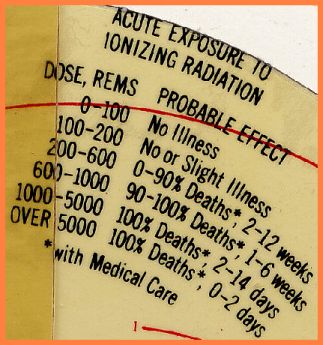|
The fission or fusion products of a nuclear weapon generate
intense emissions of neutrons and gamma radiation
as well as several species of radionuclide
or isotopes, all of them capable to
emit gamma, beta, or alpha radiation of
variable intensity in proportion to the explosion of the weapon which
generated them.
Neutrons - components of the atom's nucleus
which are emitted in a large quantity following a nuclear explosion.
These electron beams travel at a speed close to the light's
speed and can travel thousandths of meters in the atmosphere before
being weakened by the collision with the atmosphere's atoms; their
intensity is further weakened by the collision of higher density materials
and particularly by those with an high specific weight, for example,
lead. Every collision of neutrons brings about a complicated
subatomic collision and the result invariably is ionization
and induced radioactivity. As an example, when the nitrogen
atoms present in the atmosphere are hit from high energy neutron,
they are changed into carbon. The resulting radionuclide,
carbon 14, has an half-life of 5,76o years and it sticks to the oxygen
to form carbon dioxide, an indispensable component of cellular tissue.
Once within the organism it may be incorporated in the gonad's genetic
substances thus causing variation to the oocytes and gametes chromosomes'
composition and due to the emitted radiation and due to its
long half-life period genetic errors may occur in the DNA's
synthesis and thus cause genetic variations in future generations.
Gamma
Rays (or Gamma Radiation)
- They have the same nature of light rays (or electromagnetic
radiation) but of an inferior wavelength (see
plate) and frequency. The gamma rays emitted within
the first second immediately following the detonation of a nuclear
weapon can travel thousandths of meters in the atmosphere until
they are weakened by the interaction with the atmospheric atoms.
They are ulteriorly weakened by the passage through denser materials,
i.e. water, soil, cement etc. When they go though biological tissues,
which, like in the case of X-rays are transparent to
gamma radiation, they interfere with the cellular structure
causing ionization. The only adequate protection is proper shielding,
i.e. an adequate shelter. Beta radiation - it consists of high speed electron beams: these electrons cannot travel more that a few meters in the air and therefore they are not of immediate concern, as related to the immediate lethal causes of a nuclear explosion, but sources emitting beta radiation form in the fallout and in the earth at ground zero, due to the intense bombardment from neutrons. A sheet of paper is enough to stop them and hence the danger they pose is limited but, should beta-emitting radioactive dust come in contact with exposed tissue, i.e., deposit on the skin, it will cause burns which damage the cellular tissue in such a way that will require a longer time to heal. Beta contamination of the scalp will cause hair loss, while if beta particles are absorbed in the organism there is great danger for the health since they simulate chemical substances necessary to the same or they are radioactive duplicates of these chemical substances. Since the organism cannot discriminate between radioactive and non-radioactive substances it will accept them thus being poisoned or damaged by assimilating them in different organs. |
